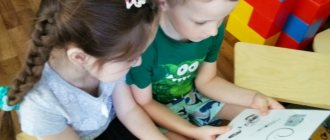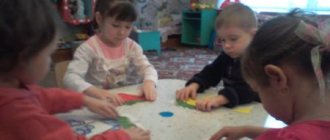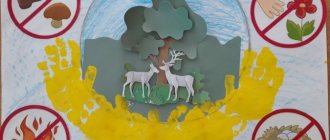content .. 1 2 3 9 ..
Education for labor activity in the first junior group of preschool educational institutions
Due to the age-related capabilities of the child’s body, the labor activity of a child of the 3rd year of life is still very limited. At this stage, the tasks of developing the prerequisites for work activity, the formation of hygienic skills and self-care skills are solved. From the age of 2, children begin to develop an interest in the work of adults and a desire to help them. For example, introducing the work of a nanny, the teacher says: “Look, children, how Anna Ivanovna washes the floor, how she tries to keep the group clean!” Or: “Who was it that scattered the paper on the floor? It will be difficult for Anna Ivanovna to assemble it alone. We will now pick up the rubbish together with Olya, Ira and Seryozha... The children did a good job! They love Anna Ivanovna and help her work.” The main thing in the labor education of children of this age is to introduce them to self-service, the formation of simple skills in this type of work. The goal for the child should be set specific, feasible, understandable, taking into account the fact that the child will see the result of the work and feel its necessity for himself:; I fastened the buttons on the sleeves with the help of an adult - it became convenient to play, the sleeves do not fall down on the hands and do not interfere; With the help of the teacher, I laced my shoes - it became comfortable to walk, the laces did not get tangled under my feet; I washed my hands myself - I felt a pleasant feeling of satisfaction, etc. The work activities of young children should take place in a playful way. Playful techniques help create a joyful, emotional mood in children, and consequently, more successful learning of work skills. So, the teacher invites the kids to teach Piggy and turns to the pig: “Learn, Piggy, to take off our guys’ tights! Now look how Sasha can wipe her nose with a handkerchief.” And so on. The formation of certain self-service skills always begins with a direct demonstration of the action, accompanied by an explanation, and then performing the action together with the children. For example, when teaching students to wash their hands, the teacher rolls up the sleeves of his robe, soaps his hands, rubs them, rinses them, wipes them, then encourages the kids to repeat these operations in the same sequence. At the same time, he tries to evoke a joyful mood in children, using poems, nursery rhymes, and songs. For example: Clean water washes Vova’s face, Tanya’s hands, and Antosha’s fingers. While reciting the song, the teacher washes Antosha’s doll’s hands, wipes them and invites the kids to dry their hands with a towel as he shows. While teaching children to take off their clothes, the teacher undresses the doll Masha, who was walking with them. She accompanies her actions with the words: “The doll Masha took off her hat and put it in the closet on the top shelf. Look, Masha, now all the guys will take off their hats and put them in their closets on the top shelves.” Etc. In the learning process, children need benevolent, emotional encouragement, timely help, and support. This stimulates the baby’s activity, causing him joy and satisfaction. From 2 to 3 years old, children learn, with the help of adults, to take off clothes and shoes (unbutton the front buttons, untie the laces), undress in a certain sequence, and neatly fold things. In this age group, it is recommended to involve children in carrying out simple individual tasks (bringing a toy, putting a ball in its place, etc.). If a child refuses to complete an order, you should not insist. It is better to use a gaming technique. For example, a teacher may say: “What a big car Vova has! Using such a vehicle, he will now quickly transport all the cubes that are lying on the floor and put them neatly on the shelf.” Or: “Our good housewife Olya, she will now pick up all the rags from the floor, fold them and hide them in the closet, and her house will be clean and tidy.” In household work, familiarization of children with a new labor operation should begin with the joint activity of the child with an adult. First, the teacher turns to the child with a request, for example, to help wipe the table. Then he tells and shows what needs to be done, calmly and kindly encouraging the child to work with him. For example: “Today Tanya will help me wipe the tables with damp cloths. These are some beautiful rags we have! This is how you need to fold a cloth and wipe the table with it: both the middle and all the corners. Tanechka worked well, how clean she wiped her table, it would have been difficult for me alone without her, I would have had to work for a long time!” Such joint activities especially help in establishing contact between a child and an adult. During work, special attention should be paid to instilling humane feelings and positive relationships in children, encouraging the child to be responsive and compassionate (“Kolya, let’s help Olya collect the cubes... That’s how friendly we are! We cleaned everything up quickly!”). The teacher should give children examples of affectionate, friendly treatment. For example, picking up a doll from the floor, the teacher asks it: “Who lost you, who is your mother? Tanya is your mother? Take my daughter, Tanya, have pity, put her in the stroller.” The creation of a friendly, emotional atmosphere in the group is facilitated by the playful technique of the episodic appearance of toys and the teacher’s conversation with the children on behalf of one or another character. For example, grandma Varvarushka, bear Toptyzhka or other fairy-tale characters may come to the kids and praise them, encourage them with affectionate words or make comments in a gentle form (“Our bear Toptyzhka noticed that Sasha is bad at putting away toys”; “Zhenya, you can’t knock a toy on a toy, this could cause them to break"). The teacher constantly instills in children a caring attitude towards all living things, teaches them to take care of the inhabitants of a corner of nature. The personal example of an adult is especially effective. So, while caring for the bird, the teacher says: “Good, beautiful bird, you are so small, we all love you, now we’ll pour some water, give some grains so that you can always sing your songs to us.” Etc. It is necessary to create in children the prerequisites for joint activities, encouraging children to briefly interact with each other, teach them to work together without interfering with each other, and show sympathy for peers (“Look, Andryusha, how difficult it is for Verochka to pick up the cubes alone and put them on the shelf! Go tell her: let's work together!" Or: "Guys! Don't you know why our bunny is smiling? Let's ask him... He told me in my ear that he was very happy. He likes how Andryusha and Irochka work together"). Didactic games such as “Let’s put the bunny to sleep”, “Let’s dress the doll Nastya”, “Treat the dolls”, etc. also contribute to children’s learning of labor skills.
content .. 1 2 3 9 ..
Junior group. Early childhood, nursery. Children 1-4 years old
Labor activity on the walk “Sowing seeds of ornamental plants” (second junior group)
Labor activity on the walk “SOUNDING SEEDS OF ORNAMENTAL PLANTS”
To form ideas: • about the features of the appearance of seeds of ornamental plants
(shape, color, surface character)
; • sequence of actions for sowing seeds of ornamental plants (spread the seeds...
Consultation for parents “How to organize the work of children 3–4 years old” Consultation for parents “ Work in the life of a child 3–4 years old”
We adults, parents and teachers, of course, want our children to become real people, love
work , and be happy. The famous teacher of our time, V. A. Sukhomlinsky, deeply believed in the ennobling power of labor :...
Long-term plan for labor education (second junior group)
Long-term plan for labor education of preschool children.
Second junior group.
Educator: Nadezhda Vasilievna Kamenskikh
Perm region, Perm region
MDOU Yugo-Kama kindergarten No. 3
Target:
to form in children an idea of the role of work in the life of society and every person.
Tasks:
To promote the development of independence, the desire to take on everyday work responsibilities, to be involved in everyday work affairs.
Form an idea of professions based on familiarization with specific types of work.
To promote awareness and acceptance of the rules of safe behavior based on ideas about objects and materials that children widely use in various activities.
| Month | Subject | Tasks | Work with children | Source | Working with parents |
| September | Washing training | Teach children to notice disorder in their appearance, wash their hands and face, use soap, and dry themselves with a personal towel. | Learning the nursery rhyme “Water, water, wash my face...”; d/i “Let’s teach the Incompetent to wash her hands”; reading the poem by K. Chukovsky “Moidodyr”. | L.V. Kutsakova Moral and labor education of a preschool child p.81 | — Exhibition of crafts “What autumn gave us”, — consultation “Nurturing independence in a child of primary preschool age”, |
| October | Hair training | Teach your child to notice disorder in his appearance, teach him to use a personal comb. | Role-playing game “Hairdresser”, reading italian fairy tales “Lazy Brucholina”, looking at the painting “In the hairdresser...” | L.V. Kutsakova Moral and labor education of a preschool child p.82 | — conversation “Appearance of a preschooler”, — visual material from the series “What is good and what is bad.” |
| November | Toy cleaning training | Teach children to put toys away after playing and maintain order. To cultivate a caring attitude towards toys, mutual assistance, independence, and a desire to work. | Communication situation “Every thing has its place”; game situation “Teaching Piggy to play with toys.” | L.V. Kutsakova Moral and labor education of a preschool child p.83 | — Visual propaganda “Our habits are the habits of our children.” |
| December | Washing doll dishes | Teach children to correctly perform individual actions and, based on their assimilation, form elementary work activities. Learn while working, maintain order in the workplace. Develop a desire to work side by side, a desire for communication in work. To consolidate children's knowledge of the general word “dishes”. To develop knowledge about the purpose of individual objects: cups, saucers, sugar bowl, plates, saucepan, frying pan, kettle. | Reading of the poem by K.I. Chukovsky “Fedorino’s grief”, d/i “Who wears what”, “Who needs what for work”, d/i “Let’s dress the doll for a walk” | L.V. Kutsakova Moral and labor education of a preschool child p.84 | — Labor landing “Construction of a snow town on the site”, — an exhibition of crafts from Grandfather Frost’s workshop. |




